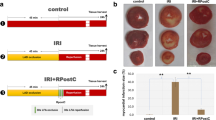Abstract
To determine the differential genes in ischemic myocardium of Wistar rats with acute myocardial infarction (AMI), we constructed two differential gene expression profiles. AMI model was generated by ligation of the left anterior descending coronary artery in Wistar rats. Total RNA was extracted from the normal and the ischemic heart tissues under the ligation point at the 8th day after the operation. Differential gene expression profiles of the two samples were constructed by using long serial analysis of gene expression (LongSAGE). Real time fluorescence quantitative PCR (Q-PCR) was used to confirm the expression changes of partial target genes. The main results were as follows: a total of 15966 tags were screened from the normal and the ischemic LongSAGE maps, and 9646 tags in the normal tissue and 9563 tags in the ischemic tissue were obtained. Among them, 7665 novel tags were identified by NCBI BLAST search. In the ischemic tissue, 142 genes significantly changed compared to those in the normal tissue (P<0.05). These differentially expressed genes may play important roles in the pathways of oxidation and phosphorylation, ATP synthesis and glycolysis and so on. Partial genes identified by the LongSAGE were confirmed by Q-PCR. The results show that AMI causes a series of gene expression changes in the regulation of the pathways related to energy metabolism.
Similar content being viewed by others
References
Velculescu V E, Zhang L, Vogelstein B, et al. Serial analysis of gene expression. Science. 1995, 270(5235): 484–487
Horvath A, Mathyakina L, Vong Q, et al. Serial analysis of gene expression in adrenocortical hyperplasia caused by a germline PRKAR1A mutation. J Clin Endocrinol Metab, 2006, 91(2): 584–596
Saha S, Sparks A B, Rago C, et al. Using the transcriptome to annotate the genome. Nat Biotechnol, 2002, 20(5): 508–512
Zhang R S, Wang J S. Discussion of some problems about rat model with myocardial infarction. J Shanxi Med Univ (in Chinese), 2004, 35(1): 13–15
Pfaffl M W. A new mathematical model for relative quantification in real-time RT-PCR. Nucleic Acids Res, 2001, 29(9): e45
Enerson B E, Drewes L R. The rat blood-brain barrier transcriptome. J Cereb Blood Flow Metab, 2006, 26(7): 959–973
Rafiee P, Shi Y, Pritchard K A Jr, et al. Cellular redistribution of inducible Hsp70 protein in the human and rabbit heart in response to the stress of chronic hypoxia: Role of protein kinases. J Biol Chem, 2003, 278(44): 43636–43644
Webster K A. Programmed death as a therapeutic target to reduce myocardial infarction. Trends Pharmacol Sci, 2007, 28(9): 492–499
Lu S M, Li W W, Wang Z G. Anoxia and hypoxia and mitocondril DNA damage. J Traumatic Surgery (in Chinese), 2001, 3(4): 295–297
Fan Z W, Wang J Z, Huang C X. Studying progress of correlation between mitochondrion and cells apoptosis. Chin J Cardiol, 2002, 30(5): 317–318
Simkhovich B Z, Kloner R A, Poizat C, et al. Gene expression profiling: A new approach in the study of myocardial ischemia. Cardiovasc Pathol, 2003, 12(4): 180–185
Lopaschuk G. Regulation of carbohydrate metabolism in ischemia and reperfusion. Am Heart J, 2000, 139(2 Pt 3): S115–119
Sheeran F L, Pepe S. Energy deficiency in the failing heart: Linking increased reactive oxygen species and disruption of oxidative phosphorylation rate. Biochim Biophys Acta, 2006, 1757(5–6): 543–552
Li Y P, Zhou C J, Hao F. Identification of Candida albicans genes with cDNA technique from LongSAGE tags. Acta Academiae Medicinae Militaris Tertiae (in Chinese), 2005, 27(20): 2028–2030
Chen J, Lee S, Zhou G, et al. High-throughput GLGI procedure for converting a large number of serial analysis of gene expression tag sequences into 3′ complementary DNAs. Genes Chromosomes Cancer, 2002, 33(3): 252–261
Friedland D R, Popper P, Eernisse R, et al. Differentially expressed genes in the rat cochlear nucleus. Neuroscience, 2006, 142(3): 753–768
Author information
Authors and Affiliations
Corresponding author
Additional information
Supported by the National Natural Science Foundation of China (Grant No. 30572430)
About this article
Cite this article
Guo, C., Yin, H., Jiang, Y. et al. Differential gene expression profile in ischemic myocardium of Wistar rats with acute myocardial infarction. Chin. Sci. Bull. 53, 2488–2495 (2008). https://doi.org/10.1007/s11434-008-0333-2
Received:
Accepted:
Published:
Issue Date:
DOI: https://doi.org/10.1007/s11434-008-0333-2




